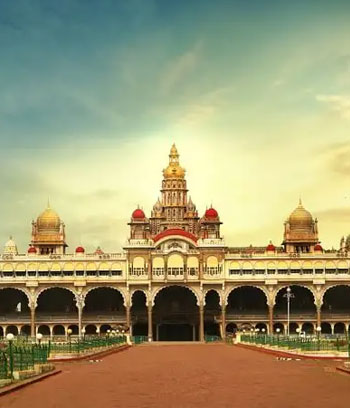
Karnataka Package
With Maharashtra and Goa on the north, Andhra Pradesh on the east, Tamil Nadu and Kerala on the south, the land of Karnataka slopes down into the Arabian Sea in the west. Population of the state as per the 2011 census is 61,095,297. Karnataka, also known as Kuntala Desa in ancient times, was the home of an enterprising people who carried on trade with the Egyptians, the Sumerians, and the Phoenicians. There was, also, close communication between the cities of Karnataka and those of the Indus Valley Civilization.
Karnataka had become a part of the Maurya Empire by the 4th century B.C. The modern Kanakagiri in Raichur district, then known as Siwamagiri, was the southern capital of the empire. A native dynasty, known as the Satavahanas or the Satakarnis took over from the Mauryas in the 1st century B.C. They expanded their empire up to the Vindhyas in the north and the whole of Deccan in the south. When the Satavahanas declined, a new dynasty, the Kadambas, founded by Trilochana, rose to prominence. Simultaneously and subsequently parts of Karnataka were ruled by the Gangas and the Chalukyas. The latter were renowned builders. The Chalukya style of architecture developed at Badami, Aihole, Pattadakal, and Lakkundi.
Another famous dynasty, the Rashtrakutas, ruled from eighth to tenth century. When the Rashtrakutas declined, three Kannada dynasties, the Yadavas of Deogiri, Kalachuris of Kalyani, and the Hoyasalas of Dwarasamudra became powerful. Much of their time and energy went to check the attempts by the kings of the neighboring states to invade their domains. Then rose the famous Vijayanagar Empire, founded by Harihar and Bukka. Their motive was not simply empire-building, but to build an invincible citadel for the Hindu religion. The two great kings of this dynasty are Devaraya and Krishnadevaraya. The empire was at the height of its glory during the reign of Krishnadevaraya.
The empire weakened and ended in the 16th century. New dynasties—the Nayaks, the Pallegars, and the Wadiyars came up. The various chieftains were subdued by Haidar Ali and he became the Sultan in the second half of the eighteenth century. His conflict with the rising British power ended in the death, while fighting, of his famous son, Tipu Sultan, in 1799. The state was restored to the Wadiyar dynasty, though it remained under the British control. Karnataka—with its long colourful past has much to offer to, the traveler.
The Indian music has two great traditions, the North Indian and the Karnatic school. Hampi is supposed to be the birthplace of the Karnatic School.
Get answers and advices from Professional Tour Consultants.

Contact No.
+91-8587983942

Our Email
info@champarantravels.com
